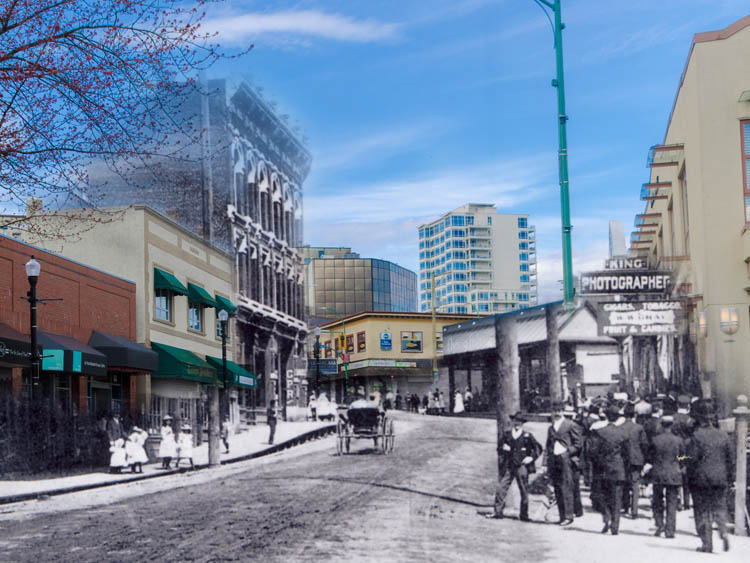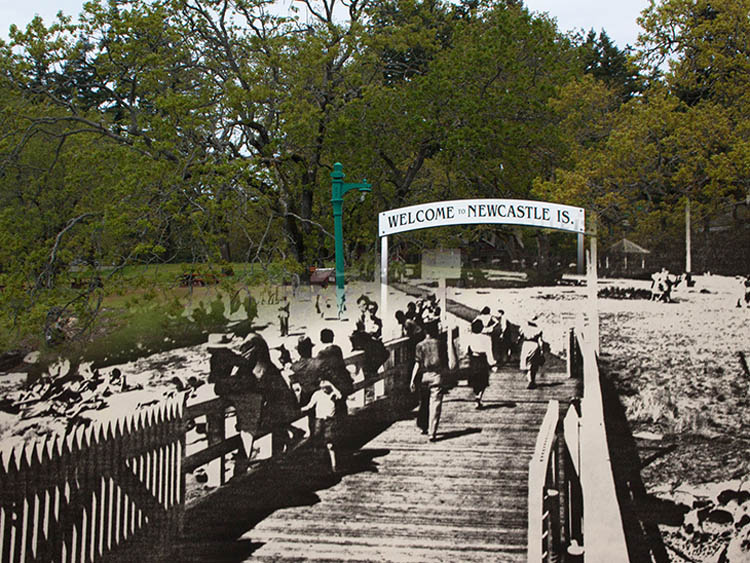Home to the Snuneymuxw First Nations for thousands of years, the place now known as Nanaimo was one of the first places in British Columbia to see substantial European settlement. In the 1850s the Hudson’s Bay Company, and later the provincial government, encouraged miners to settle in Nanaimo who could work the area’s vast coal reserves. By the late 1800s Nanaimo had grown into a bustling harbour city, providing coal for ships stopping off in B.C As mining wound down in the 1940s, Nanaimo became a hub for forestry and government services. Today Nanaimo is being reborn as a cultural centre that has preserved its rich architectural and cultural heritage.
Download the On This Spot app for Android or iOS devices to take these fascinating free walking tours today!
The tours are also all available on the web at https://onthisspot.ca/cities/nanaimo.

Nanaimo’s Waterfront: The Key to Prosperity
In this tour we will take a stroll along Nanaimo’s harbour walkway, discovering how this stretch of waterfront has shaped Nanaimo’s history and provided livelihoods for the people who called this place home. We will begin with learning about the Snuneymuxw, the First Nations people who have lived and fished here for thousands of years, and upon whose unceded territory Nanaimo is built.
Next we will see how coal first drew Europeans here, and in the 1850s how they began mining and exporting the so-called ‘black diamond’ from wharves all around this harbour. We will also take a look at Nanaimo’s two other main industries: fishing and lumber, and the city’s close connection with the United States of America.
We will see how Nanaimoites have used this harbour as the main highway that connects them to the world and chart the rise and fall of a succession of ferry companies. Finally we’ll see that the harbour isn’t just a place of economic activity, but a place that people come to for recreation and fun. As the harbour has gradually shaken off its industrial roots it has evolved into the beautiful and appealing place we know today.

Life in Early Nanaimo: How We Got Here
In this walking tour we will step into Nanaimo’s early history, seeing what life was like for the people who lived here from the 1850s to the 1920s. It begins with the early settler days and the town that grew up around the tiny cluster of log cabins and warren of mine shafts that ran under downtown and the surrounding areas.
As more immigrants came and the community grew, people embarked on all sorts of efforts to improve the city. In the 1860s and 1870s libraries, schools and a fire department were set up. New businesses sprang into being along Commercial Street and Victoria Crescent to better serve Nanaimo’s inhabitants—including a huge variety of pubs and saloons. At this time democratic self-government was set up, too (though to our eyes these halting early efforts might seem somewhat comical).
All along the way we will see the immense challenges these pioneers faced in laying the foundations for the city we know today.

The Boom Years: Nanaimo’s Post-War Transformation
In this tour we will walk through the pivotal years after World War II—when Nanaimo underwent an explosive economic boom that profoundly shaped the city we know today.The late 1940s and 1950s were an exciting time, marked by the creation of new industries, and buildings, and the arrival of new people and ideas. They all contributed to the reshaping of Nanaimo; from a hardscrabble mining town to a major Vancouver Island hub of industry, shopping and culture.

Robert Dunsmuir in Nanaimo: Captain of Industry or Robber Baron?
This tour tells the story of Robert Dunsmuir, one of the most remarkable rags-to-riches stories in Canadian history. Dunsmuir came to British Columbia from Scotland as a lowly indentured miner for the Hudson’s Bay Company in 1851. He quickly proved himself a tireless and loyal worker who rose rapidly to manage coal mining operations in Nanaimo.
In 1870 he set out to start his own mining company and before long he had quashed the already well-established competition. Using shrewd business tactics and ruthless cost-cutting—often at the expense of the well-being of his miners—he quickly became the richest man in the province.
By the 1880s when he built the Esquimalt & Nanaimo Railway, he was envied by the rich as a captain of industry beyond peer. The poor and working classes on the other hand, despised him, seeing him as a robber baron. However, even his harshest critics admitted a grudging respect for the man who manifested the virtues of hard work and initiative.

Departure Bay: From Sea to Sky
This walking tour will cover the fascinating history of Departure Bay, the broad sweep of coast north of Nanaimo. For many visitors to Vancouver Island, the first part of if they see is Departure Bay, home of Nanaimo’s major ferry terminal. Departure Bay has for thousands of years been home to the Snuneymuxw First Nation and their village of Stiil’nep, whose history is covered in great detail in a separate tour above. This tour focuses on the settler period, when Departure Bay hosted many industries such as a whaling station, coal mine, coal wharf, explosives plant, and ferry terminal. It then traces the development of this area into a peaceful place for community recreation, as you find it today.

The Island of Saysutshun: Capturing the Imagination
The 756 acres of Saysutshun (formerly known to settlers as Newcastle Island) are given over to leisure: camping, walking, biking, and bird-watching. There are no cars or roads, and only one permanently occupied dwelling. Visitors are drawn to the island’s tranquillity, natural beauty, and charm, and have been for thousands of years. Saysutshun, the island’s traditional Snuneymuxw name, means a place of rest and rejuvenation. Take this tour as you explore the island’s fascinating history and rich traditions.
Download the On This Spot app for Android or iOS devices to take these fascinating free walking tours today!
The tours are also all available on the web at https://onthisspot.ca/cities/nanaimo.


